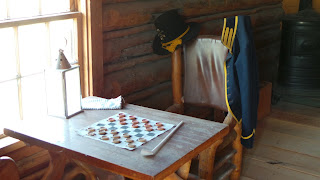As we were approaching Casper, Wyoming, the skies were getting very grey and dark and even dropped a few rain drops. Our first stop was a Wal-mart to grab a broom and a couple of items of food. Gary stayed out in the RV for a quick nap and Jena and I headed into the store and did the shopping (very nice when it is laid out in the same way as the Layton Wal-mart--made shopping fairly convenient.
As we exited out the building, I could see that it had been raining hard but it looked like it was letting up so I decided that we didn't need to call Gary but we could walk out into the back of the parking lot to where the RV was parked. After we had gone about 80 feet or so, the rain returned and I could tell that hail was not far behind it as the rain was ice cold. I told Jena to start running but we got caught in the hail storm. Hail hurts when it hits and it was sad when I heard Jena say the hail was hurting her. I just kept on helping her run to the RV. When I finally got into the RV, I was wet, cold, and still feeling the tiny jabs of the hail hitting me. I commented to Gary that I was cold.......and then it hit me. My relatives as well as most of those who traveled the pioneers trails to the west had been in those types of storms once if not many times. They described finding shelter under trees or the canvas of the wagon to wait out the storm. I just had to run to the RV at the end of the parking lot, my clothes and food and fuel were all safe and dry. I could have changed clothes immediately--they often did not have any other option than to wear their clothes and let them dry on their bodies. I didn't like the hail hitting Jena. How would it have been for me to be trying to protect Jessica, Scott, Ben, Tosha and Jena under a canvas tarp? I am not sure I would have been a very good pioneer mother!!!---that is what I decided after my own little "hail storm moment" in the parking lot in Wyoming! Another vacation moment not scripted, but meaningful none the less.
These statues are outside of Ft. Casper.
To the Native Americans, buffalo was God's sacred gift to them. They provided food, clothing, housing, and life itself at many times. The Native Americans in the Plains built their lives around the buffalo. The traveling pioneers began disrupting that life style and the settling pioneers destroyed it. Although herds of buffalos are in Yellowstone. They are missing across much of the prairies which they once roamed.
One side honoring the Oregon Trail.
The tops of the fence that surrounded the Ft.
These rooms have been maintained and some restored over the years to reflect the life of the soldier in the fort. Here was the commissary for everyone living in the fort and also to sell to passing pioneers.
Checkers helped feel the hours with nothing to do.
Trying to be ricky with a picture of the window.......
Mess Hall
Captain's desk---again the browns and greay together.
Some of the lowly privates or he scouts might have to stay in these tents especially when out on assignment. Gary asked Jena if she would be willing to camp in one of those. She said yes, but then Gary pointed out she might be sleeping on the ground somewhere. She loved at him funny and said 'No--I bring an air mattress." Smart woman....of course not historical accurate for this time. But air mattresses are always a good camping choice.
One of the main reasons I wanted to stop hear was to see the "Mormon ferry". While moving across Iowa, the Mormon Saints in the front party were building an average of one bridge a day to those who would fall behind. It actually took me a while to find it (with Gary's help). I had been looking for something much bigger that this (if you click on these pictures and save them to another window you can also read the descriptions--Won't work in the printed blog at the end of the year.)
The Mormon Ferry (1949)
This ferry was barely bigger than the wagons themselves and not significant things
holding it up either. Mormon Ferries were built along the way of some of difficult crossings
to help the Saints traveling in the later companies.
"This Mormon Ferry, as it came to be known, was the first commercial ferry at the upper crossing of the Platte, operating about where the bridge on Wyoming Boulevard crosses now between
Casper and its suburb of Mills, Wyo.
This model was relocated to the Ft. Casper Museum grounds.
My great-grandfather writes about passing over the Emigration the Bridge in this area. A search on google states: "The bridge came to be called Reshaw’s Bridge. It was built on log tiers 30 to 40 feet apart, in a diamond shape with the points aimed up and down river, filled with rocks and decked with planks. The bridge was finished in time for the start of emigration in spring 1853." This is likely the bridge he was talking about and was located down the river from Casper. Others have replaced it over the years to meet the demand first of pioneers and then of trade partners as people began settling in the prairie.
Ft. Casper was built near the Platte river, so I took a short walk to its shore



















No comments:
Post a Comment